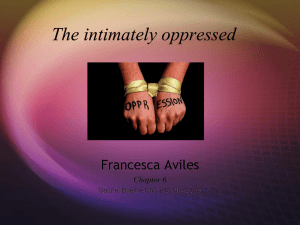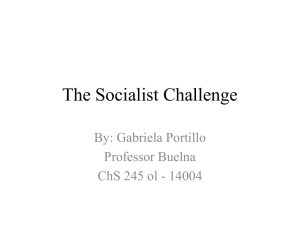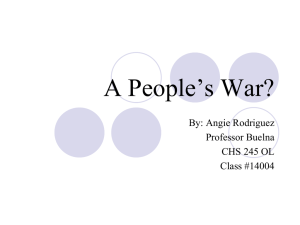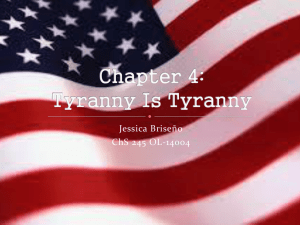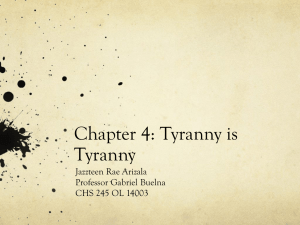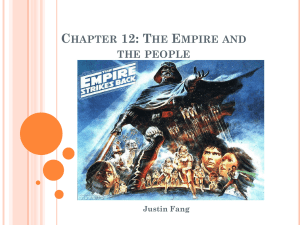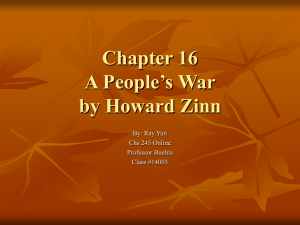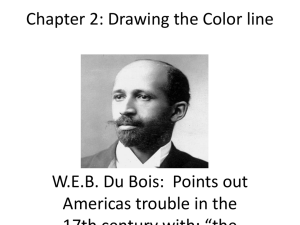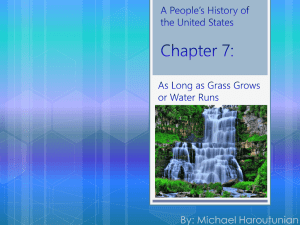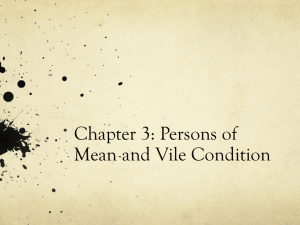Chapter 3: Persons of Mean and Vile Condition
advertisement
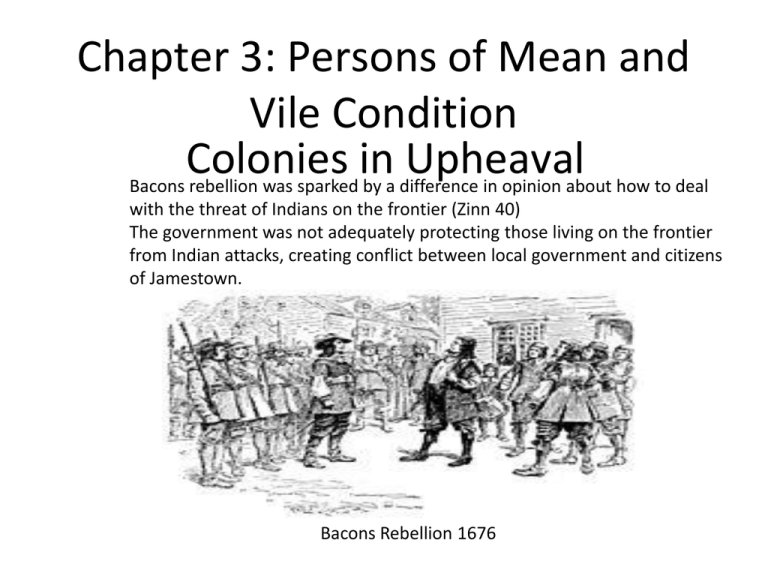
Chapter 3: Persons of Mean and Vile Condition Colonies in Upheaval Bacons rebellion was sparked by a difference in opinion about how to deal with the threat of Indians on the frontier (Zinn 40) The government was not adequately protecting those living on the frontier from Indian attacks, creating conflict between local government and citizens of Jamestown. Bacons Rebellion 1676 Nathaniel Bacon -He came from the upper class and had a-lot of land but nonetheless became a symbol for resistance of the existing order. (Zinn 41) -He was elected to the House of Burgesses in 1676 and criticized the rich and expressed hatred toward the frontier Indians (Zinn 41). -Bacon was a strong advocate for protecting the frontier using forces outside the existing structure of governance. Causes of the Rebellion: -How to deal with Indian attacks on the frontier? -Resentment toward the aristocrats and frustration over Indian aggression. Governor Berkeley Challenges Bacon -Bacon organized groups to fight against the Indians and he was declared a rebel by Governor Berkeley and arrested (Zinn 41.) -tens of hundreds of Virginians march to Jamestown in support of Bacon and Berkeley releases Bacon (Zinn 41). Bacons defeat and death -The last of Bacons forces were defeated by Thomas Grantham and the last of the rebels were hanged and the Africans were sent back to their slaves (Zinn 41). -”Leveling” is the process of poor whites toward the rich to try to level the wealth and the slaves were part of this poor underclass (Zinn 42). Indentured Servitude • • -Many Africans were deceived into slavery by signing an indenture which gave them passage to America that they paid for with 5-7 years of service as a slave. -In 1619, the Virginia House of Burgesses, provided for enforcement of treaties between servants and masters (Zinn 43). These treaties were by nature unfair and required Africans to travel long voyages across vast oceans resulting in the death and sickness of many men, women and children (Zinn 43.) • Servants faced terror and oppression at the hands of their Servants were subject to routine humiliations masters. and cruelties from their masters as Zinn explains that “Beatings and whippings were common. Servant women were raped (Zinn 44). • Women servants were controlled closely by their masters as Zinn highlights: “The master tried to control completely the sexual lives of the servants…Servants could not marry without permission (Zinn 44). This kind of Legislation is passed punishing servants who rebel • • After Bacons rebellion the Virginia legislature passed laws punishing servants who are caught rebelling against their masters (Zinn 45). Many servants decided that escape was easier than rebellion and during the 1600’s and into the 1700’s their were reports of mass desertions by white servants in the southern colonies. Throughout the colonial period the rich got richer and the poor got • • • From 1630 at the start of the Massachusetts Bay Colony the rich dominated over the lower class and the best land was given to the rich (Zinn 48). A study showed that by 1770 the top 1 percent of the population owned 44 percent of the wealth in Boston (Zinn 49). This great disparity between rich and poor caused much resentment and bitterness Poverty continued to increase within the colonies • • • • From 1687 to 1770 the percentage of poor impoverished males more than doubled from 14 to 29 percent (Zinn 49). Free white workers began to rebel against unfair treatment by the rich. Protests were happening in Maine, New York, and Boston (50-51). Much of the divisions and conflicts were strictly along class lines and involved the rich England’s war meant poverty for many in the colonies • • England was fighting in Queen Anne’s war in the early 1700’s and King George’s War in the 1730’s (Zinn 52). For merchants, according to Zinn, this meant profits, but for most it meant higher taxes and Serious problems began to develop for the wealthy elite in the Indians were toocolonies. difficult to control, slaves • were rebelling and the impoverished whites were becoming increasingly dissatisfied (Zinn 53). • Fears began to rise among the elites that these groups could some how get together to overthrow the system of rule established by the British in the American colonies. There fears were high in the Carolinas • Black slaves outnumbered whites by 15,000 and Indian tribes were scattered all around in the Carolinas (Zinn 54). – This led to the passing of laws that prohibited free blacks from traveling in areas that were designated as Indian country (Zinn 54). Despite repeated attempts to stop them slaves continued to rebel • Around the 1760’s slaves that ran away, in many cases, fled to Indian villages and found refuge and sometimes married and had children (Zinn 55). – Yet deals were made and bribes were given to • Divisions between rich and poor would continue, however something new was developing. There began to develop a class of middle class planters that would help the elites create a buffer between them and slave and Indians on the frontier (Zinn 56). -Concessions were made to the middle class whites, but at the expense of slaves, Indians and poor whites. -This class struggle would continue to divide Works Cited • Zinn, Howard. A People’s History of the United States. New York: HarperCollins. (2005). Book.
